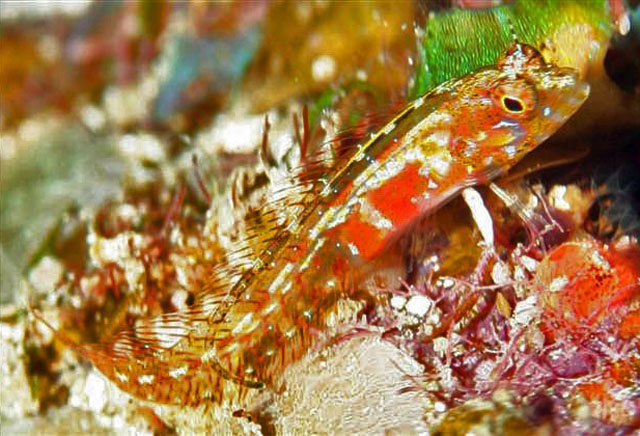| Chaenopsidae (Pike-, tube- and flagblennies) |
| 2.3 cm SL (male/unsexed) |
|
reef-associated; marine |
| Western Atlantic: off Belize and Honduras. |
|
Dorsal spines (total): 21-23; Dorsal soft rays (total): 13-17; Anal spines: 2-2. Species distinguished by: bases of first 3 anterior dorsal-fin spines separated from bases of remaining spines by a noticeable gap; first 1 or 2 spines of males elongate and filamentous, length of longest about equal to 2/3 standard length; pectoral-fin rays 14; dorsal-fin spines 21 to 23; segmented dorsal-fin rays 13 to 17; total dorsal-fin elements 30 to 38; 2 obvious segmented pelvic-fin rays (third ray vestigial or goes 5 or more times in length of longest); cirrus on eye arising from a single base, longer than eye diameter in males (and often in females); head smooth anteriorly, never spiny; tip of lower jaw not projecting beyond tip of upper jaw and fleshy projection; no stripe or series of dark blotches on head and body; one row of teeth on each palatine bone. Common amongst Chaenopsids: small elongate fishes; largest species about 12 cm SL, most under 5 cm SL. Head usually with cirri or fleshy flaps on anterior nostrils, eyes, and sometimes laterally on nape; gill membranes continuous with each other across posteroventral surface of head. Each jaw with canine-like or incisor-like teeth anteriorly; teeth usually also present on vomer and often on palatines (roof of mouth). Dorsal-fin spines flexible, usually outnumbering the segmented soft rays, spinous and segmented-rayed portions forming a single, continuous fin; 2 flexible spines in anal fin; pelvic fins inserted anterior to position of pectoral fins, with 1 spine not visible externally and only 2 or 3 segmented (soft) rays; all fin rays, including caudal-fin rays, unbranched (simple). Lateral line absent. Scales absent (Ref.52855). |
| Max. length (Joyce Burek, pers. comm., 2004). |
|
Data deficient (DD); Date assessed: 18 October 2007 Ref. (130435)
|
| harmless |
Source and more info: www.fishbase.org. For personal, classroom, and other internal use only. Not for publication.
